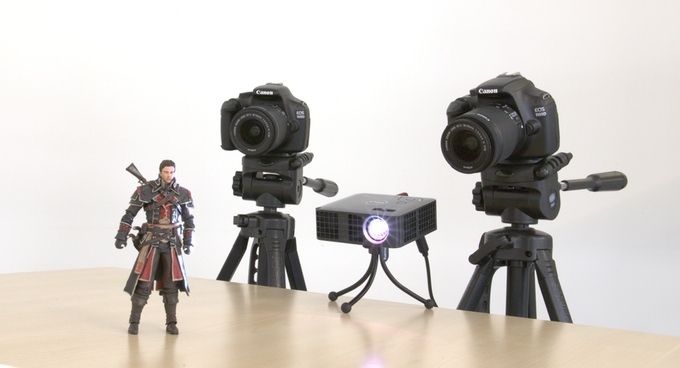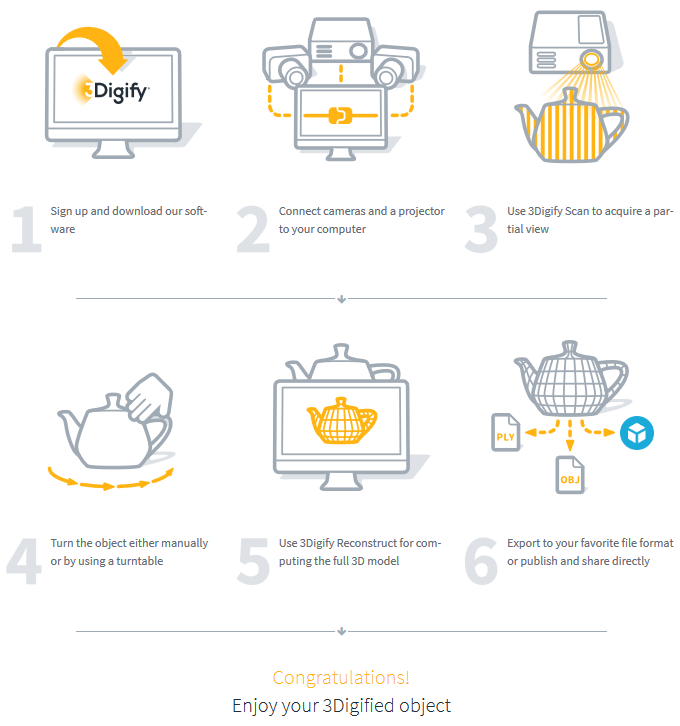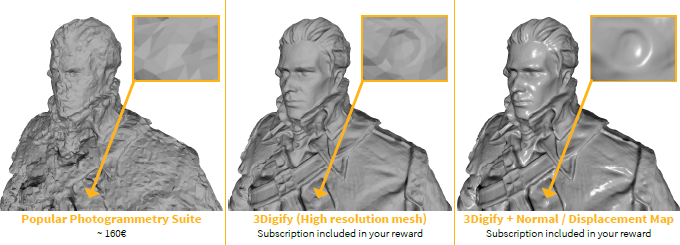A new startup offers a 3D scanning solution that has some interesting characteristics.
3Digify is a new German company founded by three Computer Vision experts, now offering early access to their 3D scanning solution. Their solution includes some new twists in both the hardware and the business model.
The 3Digify solution uses the structured light approach, where a standard light pattern is flashed onto a 3D object. Cameras observe how the light patterns bend over the object, and software interprets the images from two viewpoints into a set of 3D points. These points are combined into a fully 3D model.
First, the hardware: it’s actually yours! Other options using structured light either provide a handheld unit equipped with cameras and a projector, but in 3Dgifiy’s solution, you provide your own projector and a pair of cameras.
This is a very interesting approach, for two reasons. You likely already own cameras, be they mere webcams or expensive DSLRs. You may also have, or have access to, a projector. This could significantly reduce the cost of 3D scanning, but also could increase the quality of the results. Why? Because your DSLR cameras are no doubt of much higher resolution than the generally poorer quality cameras found in typical 3D scanning solutions.
In effect, you are “timesharing” the costs of cameras between 3D scanning applications and your normal camera use. The projector component has similar benefits.
With this hardware approach, it’s quite possible you may achieve far higher quality scans than with other 3D scanning options. Here’s an example of 3Digify’s high and low resolution, and compared with a “typical” 3D scanning product.
The other interesting aspect of 3Digify’s offer is their business model.
3Digify has two options for use of their system: a free version and a paid version, but in each case, the software lies entirely on your own equipment. The paid version permits generation of much higher quality 3D scans, but requires a subscription, which is verified by connecting to 3Digify’s cloud service.
It’s a software distribution model similar to that offered by several major software vendors who switched to cloud versions. In fact, in most cases, the software simply stays on your computer and verifies that it’s been paid for over the network. That’s the same approach here.
3Digify has launched the product on Kickstarter and has already gathered dozens of backers, each seeking a low cost, but higher quality 3D scanning solution.
But how much does it cost? The price of the hardware is, of course, your own problem, so it might be zero, or it might be the cost of buying the hardware fresh.
Should their launch succeed, the software will actually be free of charge, but for the high quality scans, you’ll need a subscription. At this time they are offering only the paid version to get things started.
They say the high-quality scan subscription will cost €300 (USD$332) per year, approximately USD$27 per month. That’s still less than the cost of many similar 3D scanning options, even after a couple of years paying for the subscription.
My take on this product is that they’re addressing two different markets, and providing each with a very low cost solution. While USD$27 per month might seem a bit high for hobbyists doing casual 3D scans, it’s actually very low for professionals that would otherwise be paying tens of thousands for higher quality scanning gear. And the hobbyists could be pleased with the free version, when it emerges.
Via Kickstarter and 3Digify





